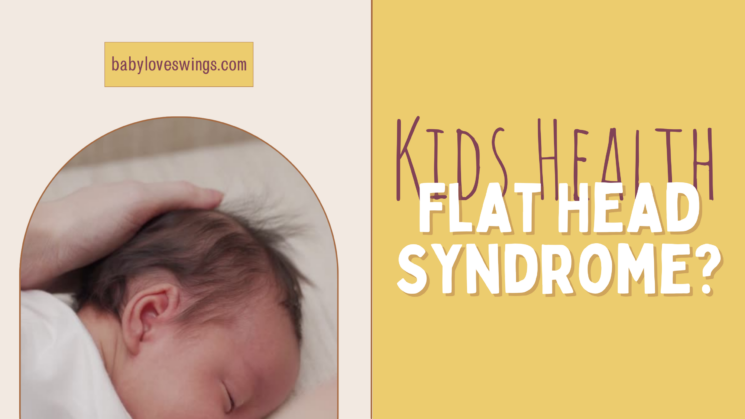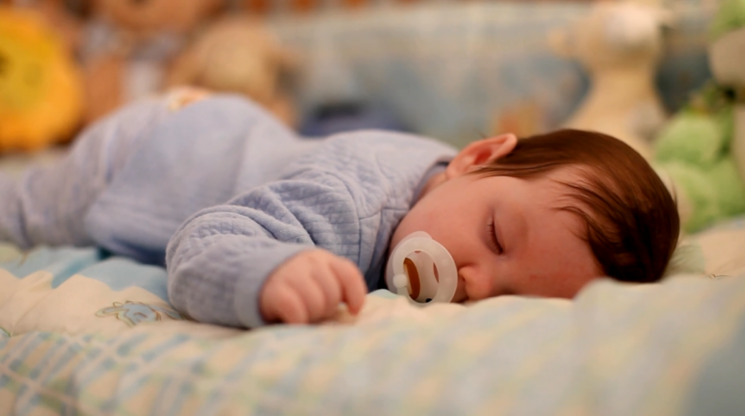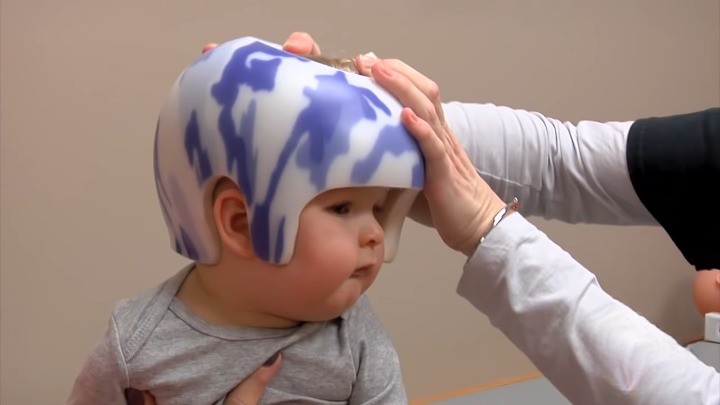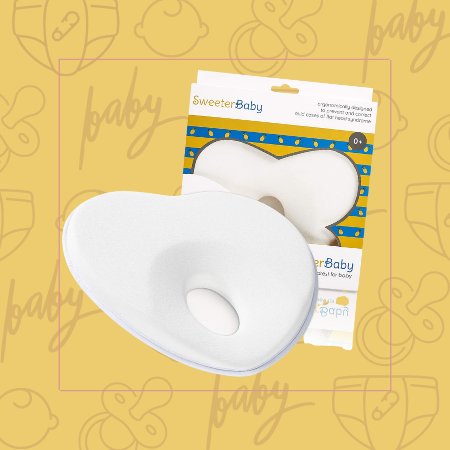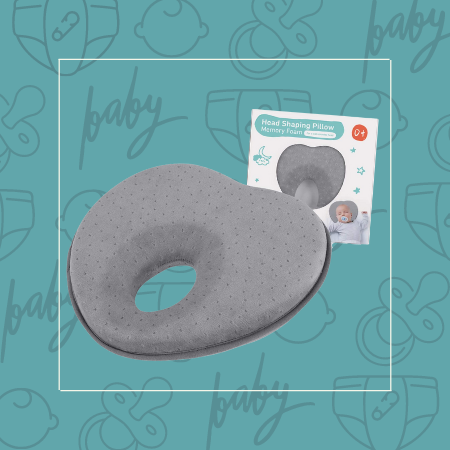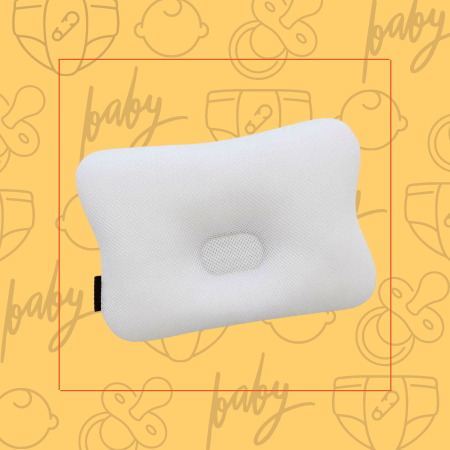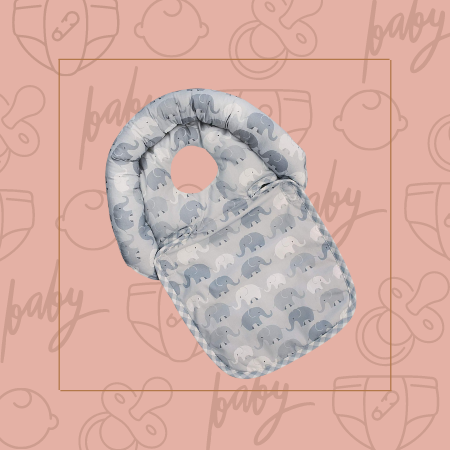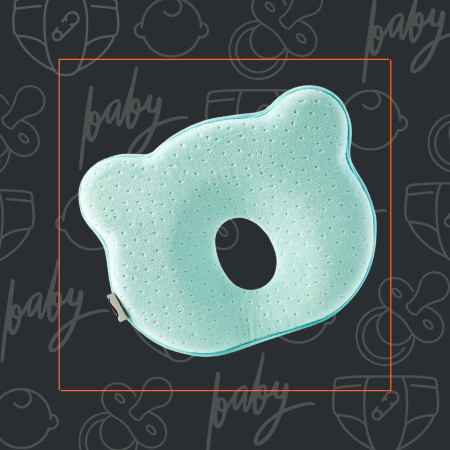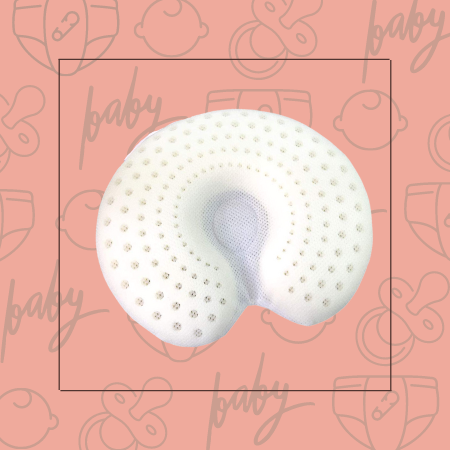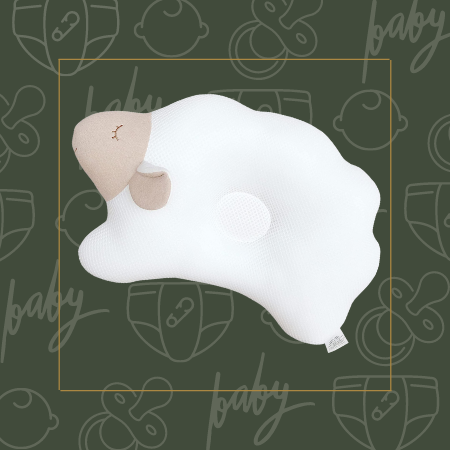Flat head syndrome, also named brachycephaly or plagiocephaly, is a type of skull deformity. This can sound very scary and very serious, but it is widespread. Around twenty-five percent of the infants suffer from some degree of flat head syndrome in their childhood years.
The flat head syndrome refers explicitly to the flattening of the skull at the back of the head. The flat head syndrome may cause the widening of the head and in some severe cases, the front of the head to bulge forward. This situation may affect the placement of the ears and eyes, giving a wonky effect.
Table of Contents
What Is Flat Head Syndrome?
Also referred to as plagiocephaly, flat head syndrome a common condition that occurs when there is the development of a flat spot on the side or back of someone’s head. This condition can change the shape of a person look asymmetrical. It can be described as a head looking like a parallelogram by other people when an observation is made from above.
This condition occurs at the early ages of a baby. The baby’s skull bones take several months after birth to fully harden and fuse up. The soft nature of the bones allows for easier passage of the baby at the birth canal, and they also provide the newborn’s brain such an ample growing time at large.
The soft nature of the baby’s bones is also an indication that the baby’s head can turn to any particular shape. The common cause of this condition is lying or sleeping most times in a similar position. It’s worth noting that flat head syndrome is not related to infant shudder syndrome.
Let’s learn the causes of this condition.
What Causes the Flat Head Syndrome
The flat head syndrome is the most prevalent type of plagiocephaly, mostly because parents have been advised by medical specialists to ensure their babies sleep on their backs to avoid sudden infant syndrome.
An infant’s skull is usually malleable for up to eighteen months after birth, and spending long periods in one position can trigger a flattening effect, also known as positional cephalic disorders and craniosynostosis.
Infants diagnosed with the flattening of heads are at long last found to be affected by positional plagiocephaly, scaphocephaly, or brachycephaly. The primary cause of these medical issues has been poor positioning in the womb, extended time used in one position, or trauma caused during birth.
There are other risk factors for developing a flat head syndrome, not directly related to the position a child is placed in for sleep. Such as, being a premature male, especially in the cases of scaphocephaly, or being in a restricted uterine environment.
The sleeping position is the primary and common cause of this cFsondition to many. You will find most infants lying on their backs several hours most days; this will cause the baby’s head to get flattened at one side. This development doesn’t not only occur while infants are asleep but also when they are in infant car seats, swings, carriers, bouncy seats, and strollers, among others.
Premature babies have a high chance of developing this problem. This is because their skulls turn to be softer as compared to the skulls of the full-term babies. These babies also often spend the most time on their backs without being picked or moved up due to maybe their medical needs. These are those like, for instance, who have been diagnosed to stay in the neonatal intensive care unit.
At times this disease can begin even before birth; for instance, if there are chances to be some form of pressure on the skull of the baby that is generated right from the pelvis of the infant or even there are cases of twins. You will more often find many babies from different births who are born with heads with such a condition.
The condition can also be brought about by tight neck muscles, which are a result of babies’ difficulties in making a turn of their heads. Since this is the thing the baby will keep experiencing, they will tend to maintain the same head position when they sleep or lie down, thereby flattening will occur.
Once the head has developed the flat spot, the neck condition, also referred to as the torticollis will develop worse.
A lot of energy is used by babies to make turns of their heads at large. So, babies who have developed severe changes for this condition will tend to stay at a similar side all the time, and eventually, their necks will turn stiff due to lack of use.
Early Signs of the Flat Head Syndrome
Medical specialists assess your child’s head shape through measurements that determine his/her cranial index. A wide range of values are taken, as usual, imagine, children skulls are growing and changing, and even as grownups, there are so many types of head shapes and sizes that we can see.
Sometimes growth itself may cause about a different appearance, which would still be considered as acceptable and of reasonable measures. If you think your child’s skull may be abnormally shaped, it is essential to ask his primary care physician to examine your baby’s head.
Some devices currently in use can help to determine your Childs cranial cavity and cranial index measurements. There are handheld instruments, laser devices, and sometimes CT scans or MRIs to be used.
Severe signs of the flat head syndrome can be seen with the naked eyes. In the normal situation, handheld tools called craniometers are the standard tools used, and in this situation, some questions appear on how accurate the measurements are. Laser machines are used by large health facilities but are still being evaluated for accuracy and reliability.
It is good to note that the medical specialists have failed to agree for a standard average cephalic index ratio, over ten measurements have been proposed since nineteen seventy-nine. This makes the analysis of scaphocephaly and brachycephaly problematic.
These conditions are evaluated using the cranial index. If laser devices become reliable and useful for cephalic index measurements, it will become easier to recognize and treat both of the conditions before they graduate to moderate or severe levels.
All this argument of a standard head shape looks interesting, but it’s good to know that a familial understanding of skull shape may help play a role in assisting the expert determine if your child’s skull is well shaped or not. If the parents have a square, elongated, rounded or triangular head, your child may appear to have skull problem, but most perfectly normal.
The Symptoms of This Condition
Parents quickly notice this condition at large. Among the signs and symptoms for it includes the following;
You will notice one side to be flatter at the back of the baby’s head.
- The flattened part will have less hair.
- If you try to look directly down at the kid’s head, you will notice that the ear at the flat side appears to be pushed forward.
- If the condition gets to be a severe case, the forehead can at times bulge on the opposite side from that which has flattened, and it will have an uneven look. In case torticollis is the cause for this, the face, jaw, and neck might also look uneven.
Does Flat Head Syndrome Correct Itself?
It’s something obvious that mild flat head syndrome doesn’t necessarily require to be treated. The problem can fix itself as the baby keeps on growing all through. If you have ever noticed, the baby’s head keeps attaining shape day in day out. Every baby’s head shape will keep improving naturally as her head grows.
Effects of the Flat Head Syndrome
Research is being conducted on the long term effect of scaphocephaly, brachycephaly, and plagiocephaly. Some medical practitioners believe that the skulls of children found with the flat head syndrome will get back to normal before the kids get to their teenage years, even without major treatments. Others question this belief for lack of long term research on the flat head syndrome.
One primary reason why information is so scarce in this particular field is the drastic rise cases which occurred following the Back to Sleep campaign implementation in nineteen ninety’s, which reduced the number of sudden death syndrome by forty percent while at the same time raising the number of positional flat head syndrome cases unknowingly.
Research is still trying to find ramifications of these positional cephalic disorders. Some physicians still believe children with flat head syndrome may encounter motor skills problems and are highly prone to developmental delays compared to their peers.
Children diagnosed with craniosynostosis and not positional flat head syndrome have flattened skulls or odd-shaped skulls as a consequence of cranial sutures that grow too early, they may have the same symptoms or very similar to those of brachycephaly, scaphocephaly, and plagiocephaly.
Unfortunately, in positional cephalic disorders, surgery is often advised to reduce the growing cranial pressure and prevent severe damages such as seizures, developmental delays, and blindness.
Can Flat Head Syndrome Cause Brain Damage?
The long term effect of flat head syndrome when untreated for an extended period could be brain diseases. Brain cerebral ventricle can be expanded due to pressure caused by flat sleeping.
In research, brain diseases such as Alzheimer’s are found to be caused by brain pressure, but the source of this pressure has been generalized as unknown. The barrier separating the blood and brain cannot function well when under pressure.
The membrane/barrier, therefore, allows heavy metals to pass over to the brain, such as mercury, aluminum, as well as bacteria and viruses, which could have otherwise been prevented. This is the primary cause of brain damage in persons with flat head syndrome.
Newborn flat head syndrome
Since infant death syndrome information became available, mothers are now advised not to lay their infants on their tummy to sleep but to use their backs instead. This has led to a reduction in sudden death syndrome, which is a piece of excellent news, but negatively, it has influenced many children with the flat head syndrome. A third of babies who sleep on their backs have this problem to some extent.
With premature infants among some other kids who are particularly more prone to this condition. Luckily though, if this problem develops, there are solutions that are very effective and simple, with no risk to the infant. This flattening can be prevented and rectified by just following a few basic principles. The primary thing to keep in mind is the younger you begin implementing these methods, the better the outcome.
Physiotherapy for the flat head syndrome
Counter-position therapy
Generally, it’s ever advisable that our babies sleep on their backs as a reason for reducing the SIDS risks at large. But then, it can be better you stay mindful of making changes in their sleeping position. For instance, if your kid favors resting with the left cheek, ensure after some time you position their head to sleep against the right cheek.
Exercise
To individuals whose babies have developed muscular torticollis, the physician can advise you to get the baby in regular stretching exercises so that you increase her neck motion range. Avoid exercises involving stretching of the neck without directions and approval from the doctor.
Molding helmet therapy
This technique involves purchasing a custom-molded band or helmet for your baby to wear. This will help the kid reform the skull from an asymmetrical looking shape to a symmetrical one.
According to expert surgeons, this helmet should be worn by children of the age between three to six months. The skull will take a period of up to 12 weeks for it to gain its better shape. This technology is also best for those with moderate to severe cases of this problem at large.
To obtain the right molding helmet, you will require a medical prescription from an expert. The helmet also should be worn all times except only the time they need to bathe.
At times, these helmets can make a baby upset or fussy or even cause skin irritation at large. Research has been done, and there is inconclusive evidence on the helmet’s effectiveness. However, before you take a step to use this type of treatment, there is a need that you discuss the risks and benefits of the method at large with your physician.
Surgery
This is not the preferred option in case you are suffering from positional plagiocephaly. It is widely used in most congenital plagiocephaly cases when the sutures have entirely closed up, and there is a need for pressure in the skull to get off.
How to Cure Flat Head Syndrome in Babies
Reposition is the best treatment that can be administered to a baby if this condition is detected early enough. It is the best when the infant is of the age of five months and below, so the sooner you detect this disorder, the better. The treatment is said to be the first line of cure so that to reduce the pressure that might be causing the development of the flatness.
Another form of treatment of this condition is by changing the sleeping position of the baby, ensure the baby spends little time in swings or the bouncy seats, and also providing the baby with maximum tummy time.
As said, if you do it early and more aggressively to give the kid the repositioning therapy, the better effects the treatment will bring about on the shape of the baby’s head.
However, there are other kids whose heads seem much softer as compared to others at large. You will also note that some babies’ conditions might turn out to be more severe as compared to others. So, the parents’ efforts in providing them the repositioning therapy can at times not be enough to correct this problem.
In case the kid has been diagnosed by the muscular condition, then considering the physical therapy to administer the state can be the best option to go with.
To those who will develop more severe or acute cases from late detection of the condition, or in case the repositioning cure seems not effective, considering a cranial remolding or having a baby helmet is the right thing you need to do. The helmet is worn purposely to correct the shape of the baby’s head.
The treatment course takes a period of about three to four months; however, in severe cases, you can, at times, require two helmets as the baby might outgrow a particular helmet before full changes occur. The helmet should be worn for 23 hours a day during the entire treatment period at large.
In case the treatment is craniosynostosis, considering surgery can be the remaining method to treat this condition.
How can Flat Head Syndrome be Prevented or Treated from children?
Use of baby Carriers and Slings.
Because babies cannot move by themselves, they will always spend most of their time in your car seat, arms, and baby bouncers, among others. This moment spent in any chair or bed can add to the chances of flat head, but if you carry your baby with you on a carrier or sling, you will be reducing the amount of time spent by your child with the back of the head against a flat surface.
If you need to put your infant in a stroller, bouncer, swing, or car seat most of the time, you should use special pillows made to keep pressure off the back of the head. These must always be done with supervision and care.
Tummy Time
An infant should lie in a variety of ways, and this is essential to reduce flat head syndrome in your baby. The tummy time mostly is advantageous under supervision, allow your infant enough time to sleep with the tummy.
If very young to lift their heads by themselves, place the head to one side. It is very critical that you always turn the baby on the back to sleep. The more often and earlier you can do tummy time with your infant, the more joyful the baby will be used to get with being on the tummy.
If the baby does not want the position at the start, concentrate on doing it more in short sessions, even a few periods until the kid gets used, it is helpful the more often you do it. With time, the infant will be more joyful in this position. Tummy lie is also essential for other areas of growth, as well. So do not neglect it.
Change Baby’s Sleep Positioning
Varying your baby’s sleeping position at various intervals usually goes a long way to reduce the chances of a baby getting flat head syndrome, and to resolve a flat spot if already started. The primary thing is to ensure you alternate the directions that your baby is sleeping within the crib.
The kid will usually try to look out of the crib towards the door or room and will be turning the head in the same direction. Putting a lot of effort in the same area on the back of his/her head, therefore, each moment you put the kid in the crib make sure to put him/her on a different position, but it’s good to know many other factors such as torticollis which are at work.
You can also speak with your health care specialist because physical therapy and specialized exercises may also be recommended. It is also essential to keep turning the position in which you hold and carry the baby, for example, on different shoulders.
Unique infant sleep positioners are available in the market that is manufactured specifically to keep your kid in a particular sleep position, which means the child’s caretaker can change the sleeping spot for the baby every time he/she is put to lie down.
What if all of these methods are not enough?
Putting the above measures into work will reduce the chances of your child developing the flat head syndrome. However, it’s good to note that despite the effort you put, sometimes it is impossible to stop flat spot syndrome from developing. No need to fill guilty on this! If the situation is very serious and the kid is young enough, for example, a year old all approximately close to that, a unique orthotic kid helmet can be built to fix the issue.
The kid puts on the helmet for about twenty-three hours a day for three to six months, and it’s ordinarily comfortable for the baby. It is of primary advantage to get advice early from your health specialist, when you think a flat spot is growing, as this type of medication is best done when it’s early as possible, usually as young as five months if the flatness is big enough to be visible.
Can Head Syndrome Treatment for Adults Fix Itself?
While the effect of the flat head syndrome is most prevalent to infants, and in many patients, disease prevention strategies appear transformative and dramatic, the fact is that some people resist changing the sleeping behaviors unto adulthood.
They get conditioned to sleep in a particular way since their birth. And when you change their sleep position, it is hard to achieve compliance when the individual is unconscious. It, therefore, takes a lot of desire to change a person’s sleep behavior. But it is worth the hardship as victims usually use a month or less to alter sleeping behavior.
To treat flat head syndrome in adults, all you need is to elevate the head for adequate blood flow. The conventional method for head elevation is using pillows, a forming wedge, putting blocks below the legs of the bed, on the head side of the bed, or making use of an adjustable bed. Whereas the perfect position is between ten to thirty degrees elevated, ten degrees elevation is right, for a start.
The legs of the bed should also be slightly lifted, too, and the individual can try to stay on the back for as long as they can. The perfect position should be one you could be in if leaning in a recliner chair. Also, you should be aware that some people will be more comfortable on a specific degree elevation than another.
Persons with higher blood pressure will need their heads more elevated than those with low blood pressure. Other people may have a shoulder and some neck discomfort from the new or therapist position. However, by getting used to pillows below the arms, under the buttocks, and below the legs/feet, the patient will find a more comfortable position.
How to Fix Flat Head Syndrome in Adults
It is an unfortunate thing to the adults as the only treatment of this condition is through surgery, and usually, there are a few of the specialists who will be willing to take you through the entire procedure. Since this disorder is said to be mostly cosmetic, the general treatment costs and risks involved with surgery will outweigh the final benefits you need to achieve.
Parents are these days advised to consider repositioning the heads of their babies early for their betterment. Through this, they will vary the position at which their kids sit, play, and sleeps so that they can relieve the skull’s backpressure at large. This cure is best and can go out successful when diagnosing mild cases of this condition. In case it fails, considering a helmet can be the best option to correct the problem.
As time goes by, babies will become toddlers, and they will, most times, be moving independently. At this time, there can be a limit at which repositioning can show out results. At the same time, since the helmets are meant to treat moderate and severe conditions to babies, the method can turn more ineffective once the child is about 14 months since this time, the skull bones start to harden.
Outlook for Adults with This Condition
To every adult, this might not be something they would wish to develop in life. But then, this is not something to stress you at all since the condition is relatively benign, and to may, it popular to its association with no other health risk in life.
These days, the awareness of this condition has shown to be on the rise at large. The healthcare professionals have consistently advised the parents on the detection of this condition at the early stages. But then, the increase is due to the negligence of parents to learn early preventive measures to avoid it.
To adults, since it will sound somehow regrettable in being unable to make early correction of the problem, still there is a chance to make a difference. This is through making other parents always aware of the urgency of the condition therapy with which action is needed if the plan to provide their kids treatment.
How to Prevent Flat Head Syndrome
All incidences of this problem can’t be prevented; however, there are several things you can decide to do to reduce the risk of other types of this disorder from happening. Some of these preventive measures are;
Ensure that the baby’s sleeping position is consistently changed in that one day, let the head face the right direction, then the following day, let it be at the left side and make consistent changing at large. Unless otherwise you have been given directions by an expert physician, the baby should always sleep right with their back at large.
Next, you need to consider providing the baby maximum supervised tummy time. The first session should start with a period of between three up to five minutes, and this should be done at least three times a single day. This will be done soonest you bring the baby from the hospital or within a particular time following the baby’s birth. For a tummy time in a single day, ensure you work up to even up to an hour.
If possible, most times, when babies need to sleep or rest, consider holding them upright instead of placing them at the baby swing, at their crib, or even the car seat.
The feeding positions of the baby should also be changed at large. For example, if you choose to bottle feed the baby while they are relaxed or nestled at the left-hand side arm, consider switching to the right one.
With all these, we can conclude that this is a frustrating condition, and it needs to be prevented early. Early detection is required so that things can work out quickly and efficiently as possible.
Before you take a step to cure this problem with any particular method, inquire from an expert physician so that you have the best information on how to do it. As usual, prevention is better than cure. Therefore, you should ensure you consider the available prevention measures before this problem hits you. Get it right, and everything shall go right for you.
Flat Head Baby Pillow Recommend
#1. Sweeterbaby Baby Pillow for Flat Head Syndrome
#2. ZOSTRATI Baby Head Shaping Pillow
#3. Bebo Beba Newborn Baby Head Shaping Pillow
#4. Babebay Baby Pillow for Newborn Infant
#5. W WelLifes Baby Pillow for Newborn Breathable 3D Air Mesh Pillow
#6. Babymoov Lovenest Baby Head Support
#7. Boppy Noggin Nest Head Support
#8. Babebay Newborn Baby Head Shaping Pillow
#9. Breathe-Thru Baby Head Shaping Pillow
10. Organic Cotton Baby Protective Pillow


